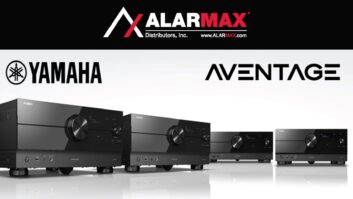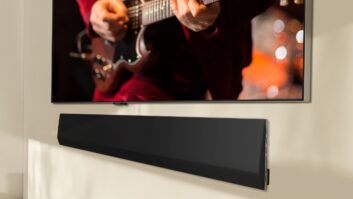Several months back, I reviewed a relatively new wireless music system from Yamaha dubbed MusicCast. If you haven’t read it yet, or if you’ve simply forgotten the details of it, I encourage you to dig it up online, because this month’s review could be considered something of a sequel. Or, more aptly, an extension of that first MusicCast review. Because for all of its merits as a standalone powered soundbar/wireless subwoofer solution, what makes Yamaha’s YAS-706 really tick is its MusicCast connectivity, and all that that implies.
It is, for example, one of the things that makes the YAS-706 such a breeze to set up in terms of wireless connectivity and music streaming. But before we delve into that, let’s look at the YAS-706 for a moment from the perspective of its physical connectivity, because it’s certainly no slouch in that department, either.

Unlike Yamaha’s YSP-series soundbars, the YAS-706 doesn’t rely on the company’s sound projection technology and a ton of drivers to simulate the effects of a surround sound system.
Typical of Yamaha’s newer soundbars, but still something of an oddity in the broader soundbar market, the YAS-706 boasts the latest in AV connectivity, including two HDMI inputs (and one output) that support the 2.0a spec, with HDCP 2.2 compliance. In other words, it’s fully capable of passing through the latest in Ultra High Definition video, including HDR. It also decodes all of the usual suspects from DTS and Dolby Digital, including Dolby TrueHD, Dolby Digital Plus, DTS-HD Master Audio, DTS-Neo 6, and DTS 96/24–though not object-based surround formats like Atmos and DTS: X.
Unlike Yamaha’s YSP-series soundbars, the YAS-706 doesn’t rely on the company’s sound projection technology and a ton of drivers to simulate the effects of a surround sound system; instead, it features simpler Air Surround Xtreme processing to add breadth and depth to the soundstage. The reason for this basically boils down to the fact that the YSP soundbars are significantly deep units and require precise placement, and generally don’t lend themselves nearly so well to wall mounting. In fact, the wall mount for the YAS-706’s rough budgetary equivalent, the YSP-2700, could best be described as more of a wall shelf than a mount.
The YAS-706, by contrast, is designed to work (pretty much) equally well with flat placement on a stand or pedestal, or rotated forward and mounted flat on a wall. I say “(pretty much) equally well” because it seems that wall mounting is the preferred configuration, in that it puts the soundbar’s status indicator LEDs in better view, and also presents a larger surface to the listener. But given the configuration of the drivers, either placement works just about as well as the other from a sonic perspective. The YAS-207 features two tweeters for each of its left-right channels, one that faces forward and one that faces upward when the soundbar is placed on a tabletop; when wall mounted, one tweeter faces forward and the other downward. There’s also a single midrange driver for each channel that’s mounted on a diagonal, and thus is pointed 45 degrees off-axis to the listener in either position. Finally, two three-inch woofers point upward when the soundbar is table-mounted and forward when it’s wall-mounted.
Whichever configuration you choose, setup is such a breeze that there’s almost nothing to say about it. You simply make your AV connections, turn on the soundbar, power up the subwoofer, wait for the two to sync, and that’s that. If you choose to wire the sub to the soundbar with an RCA cable, there’s also a 3.5mm trigger port on each that you’ll want to connect so that the two power up and down at the same time.
Any tweaks that you need to make to the system are easy and straightforward, thanks to the YAS-706 onscreen menus, but unless you want to run the sub wired, it’s unlikely that you’ll need to fiddle with anything. And if you’re an iOS user, adding the soundbar to the home’s Wi-Fi network is as simple as pressing the button on your phone labeled, “Set up new AirPlay speaker.”
From start to finish, it honestly took me longer to unbox the soundbar and its accompanying subwoofer than it did to connect and configure everything and start listening. And yes, that includes setting up all of the streaming and multiroom capabilities that come with MusicCast.

You simply make your AV connections, turn on the soundbar, power up the subwoofer, wait for the two to sync, and that’s that
The other thing worth noting is that the YAS-706’s remote is simplicity incarnate. I’ve dealt with a number of soundbars whose functionality matched that of the 706, and rarely have I seen one so easy to control on a day-to-day basis. That may be due to the fact that the MusicCast app does some of the heavy lifting in terms of the streaming side of things. And the onscreen menus certainly lighten the load required for setup. But the remote features little more than buttons for volume control (including on-the-fly subwoofer adjustment), source selection, and EQ presets, because that’s all it really needs. For what it’s worth, if you’re installing the YAS-706 in a larger installation that features advanced control, I was able to integrate it with my Control4 system, via IP, quickly and easily.
I tend to hate EQ presets on most soundbars that I’ve evaluated. Here, however, they work effectively and sound quite nice. None are what you would describe as perfectly tonally neutral, and all tend to introduce an emphasis on the upper midrange/lower treble (some more than others), but I found that when watching Mad Max: Fury Road, the “Movie” EQ preset resulted in a strong, hard-hitting, dynamic mix in which dialogue rang through beautifully, even without Yamaha’s (excellent) Clear Voice processing engaged, and bass was quite surprising, reaching down below 30Hz (kind of a shock given the size of the sub’s driver).
A change to the “Music” EQ preset definitely made things sound kinda funky with movies, but switching over to a stream of the Allman Brothers’ “Blue Sky” I found that it brought out richness, depth, and detail in the music without making it sound overly processed. Likewise, the “TV Program” EQ setting worked wonders for talking-head content like Weather Underground. Generally speaking, I go straight for the Stereo setting on most soundbars (and there’s one here), but I found that all of the surround presets worked well on the YAS-706, lending depth and breadth to pretty much any source, even if they never quite reached the true surround sound verisimilitude of Yamaha’s YSP sound projectors.
714.522.9105
usa.yamaha.com
Kudos
The YAS-706 is a strong, dynamic, clear, and quite great-sounding soundbar that fits beautifully into Yamaha’s MusicCast multiroom audio ecosystem. It’s also simple to use despite its advanced connectivity.
Concerns
For what it offers, the YAS-706 is slightly on the pricey side at $999.95. For just $200 more, you could upgrade to the YSP-2700, which offers much more advanced surround processing.
Product Specs
► Drivers: Dual 2-1/8” woofers, dual 3” built-in subwoofers, four 3/4” tweeters (center unit), 5-1/2” cone woofer (subwoofer)
► Output Power: 285 W total power: 210 W + 75 W subwoofer
► HDMI:2 in / 1 out
► 4K Pass-through: Yes (50 / 60 Hz YCbCr=4:4:4, HDR, HDCP2.2)
► 3D Pass-through: Yes
► ARC: Yes
► CEC: Yes
► Auto Lip-Sync: Yes
► Digital Optical: 1 in
► Digital Coaxial: 1 in
► Analog Audio: 1 in
► Subwoofer output: Yes







